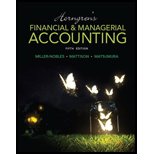
Horngren's Financial & Managerial Accounting (5th Edition)
5th Edition
ISBN: 9780133866292
Author: Tracie L. Miller-Nobles, Brenda L. Mattison, Ella Mae Matsumura
Publisher: PEARSON
expand_more
expand_more
format_list_bulleted
Textbook Question
Chapter 8, Problem 8.23E
Journalizing note receivable transactions
The following selected transactions occurred during 2016 and 2017 for Mediterranean Importers. The company ends its accounting year on April 30.
| 2016 | |
| Feb. 1 | Loaned $20,000 cash to Candace Smith on a one-year, 6% note. |
| Apr. 6 | Sold goods to Green Masters, receiving a 90-day, 9% note for $10,000. Ignore Cost of Goods Sold. |
| Apr. 30 | Made a single entry to accrue interest revenue on both notes. |
| ? | Collected the maturity value of the Green Masters note. |
| 2017 | |
| Feb. 1 | Collected the maturity value of the Smith note. |
Journalize all required entries. Make sure to determine the missing maturity date.
Expert Solution & Answer
Trending nowThis is a popular solution!

Students have asked these similar questions
Kindly help me with accounting questions
Financial accounting
Hi expert please help me
Chapter 8 Solutions
Horngren's Financial & Managerial Accounting (5th Edition)
Ch. 8 - Prob. 1QCCh. 8 - When recording credit card or debit card sales...Ch. 8 - Which of the following is a limitation of the...Ch. 8 - The entry to record a write-off of an...Ch. 8 - Brickman Corporation uses the allowance method to...Ch. 8 - Brickmans ending balance of Accounts Receivable is...Ch. 8 - At December 31 year-end, Crain Corporation has an...Ch. 8 - Using the data in the preceding question, what...Ch. 8 - At year-end, Schultz, Inc. has cash of 11,600,...Ch. 8 - Using the data in the preceding question, assume...
Ch. 8 - What is the difference between accounts receivable...Ch. 8 - Prob. 2RQCh. 8 - Prob. 3RQCh. 8 - When dealing with receivables, give an example of...Ch. 8 - What type of account must the sum of all...Ch. 8 - Prob. 6RQCh. 8 - What are two common methods used when accepting...Ch. 8 - What occurs when a business factors its...Ch. 8 - What occurs when a business pledges its...Ch. 8 - Prob. 10RQCh. 8 - Prob. 11RQCh. 8 - Prob. 12RQCh. 8 - Prob. 13RQCh. 8 - When using the allowance method, how are accounts...Ch. 8 - Prob. 15RQCh. 8 - Prob. 16RQCh. 8 - How does the percent- of-sales method compute bad...Ch. 8 - How do the percent-of-receivables and aging-of-...Ch. 8 - What is the difference between the...Ch. 8 - Prob. 20RQCh. 8 - Prob. 21RQCh. 8 - Prob. 22RQCh. 8 - Prob. 23RQCh. 8 - Prob. 24RQCh. 8 - Prob. 8.1SECh. 8 - Prob. 8.2SECh. 8 - Applying the direct write-off method to account...Ch. 8 - Collecting a receivable previously written...Ch. 8 - Prob. 8.5SECh. 8 - Applying the allowance method (percent-of-sales)...Ch. 8 - Applying the allowance method...Ch. 8 - Prob. 8.8SECh. 8 - Prob. 8.9SECh. 8 - Accounting for a note receivable On June 6,...Ch. 8 - Prob. 8.11SECh. 8 - Recording a dishonored note receivable Midway...Ch. 8 - Prob. 8.13SECh. 8 - Defining common receivables terms Match the terms...Ch. 8 - Prob. 8.15ECh. 8 - Journalizing transactions using the direct...Ch. 8 - Use the following information to answer Exercises...Ch. 8 - Use the following information to answer Exercises...Ch. 8 - Accounting for uncollectible accounts using the...Ch. 8 - Journalizing transactions using the direct...Ch. 8 - Journalizing credit card sales, note receivable...Ch. 8 - Journalizing note receivable transactions...Ch. 8 - Journalizing note receivable transactions The...Ch. 8 - Journalizing note receivable transactions Like New...Ch. 8 - Evaluating ratio data Chippewa Carpets reported...Ch. 8 - Prob. 8.26ECh. 8 - Prob. 8.27APCh. 8 - Accounting for uncollectible accounts using the...Ch. 8 - Accounting for uncollectible accounts using the...Ch. 8 - Accounting for uncollectible accounts...Ch. 8 - Accounting for notes receivable and accruing...Ch. 8 - Accounting for notes receivable, dishonored notes,...Ch. 8 - Using ratio data to evaluate a companys financial...Ch. 8 - Prob. 8.34BPCh. 8 - Prob. 8.35BPCh. 8 - Accounting for uncollectible accounts using the...Ch. 8 - Accounting for uncollectible accounts...Ch. 8 - Accounting for notes receivable and accruing...Ch. 8 - Accounting for notes receivable, dishonored notes,...Ch. 8 - Prob. 8.40BPCh. 8 - Prob. 8.41CPCh. 8 - Prob. 8.42PSCh. 8 - Prob. 8.1CTDCCh. 8 - Paulines Pottery has always used the direct...Ch. 8 - Prob. 8.1CTFCCh. 8 - Use Starbucks Corporations Fiscal 2013 Annual...
Knowledge Booster
Learn more about
Need a deep-dive on the concept behind this application? Look no further. Learn more about this topic, accounting and related others by exploring similar questions and additional content below.Similar questions
arrow_back_ios
SEE MORE QUESTIONS
arrow_forward_ios
Recommended textbooks for you
 Financial Accounting: The Impact on Decision Make...AccountingISBN:9781305654174Author:Gary A. Porter, Curtis L. NortonPublisher:Cengage Learning
Financial Accounting: The Impact on Decision Make...AccountingISBN:9781305654174Author:Gary A. Porter, Curtis L. NortonPublisher:Cengage Learning Cornerstones of Financial AccountingAccountingISBN:9781337690881Author:Jay Rich, Jeff JonesPublisher:Cengage Learning
Cornerstones of Financial AccountingAccountingISBN:9781337690881Author:Jay Rich, Jeff JonesPublisher:Cengage Learning Intermediate Accounting: Reporting And AnalysisAccountingISBN:9781337788281Author:James M. Wahlen, Jefferson P. Jones, Donald PagachPublisher:Cengage Learning
Intermediate Accounting: Reporting And AnalysisAccountingISBN:9781337788281Author:James M. Wahlen, Jefferson P. Jones, Donald PagachPublisher:Cengage Learning- Principles of Accounting Volume 1AccountingISBN:9781947172685Author:OpenStaxPublisher:OpenStax College
 Financial AccountingAccountingISBN:9781305088436Author:Carl Warren, Jim Reeve, Jonathan DuchacPublisher:Cengage Learning
Financial AccountingAccountingISBN:9781305088436Author:Carl Warren, Jim Reeve, Jonathan DuchacPublisher:Cengage Learning

Financial Accounting: The Impact on Decision Make...
Accounting
ISBN:9781305654174
Author:Gary A. Porter, Curtis L. Norton
Publisher:Cengage Learning

Cornerstones of Financial Accounting
Accounting
ISBN:9781337690881
Author:Jay Rich, Jeff Jones
Publisher:Cengage Learning

Intermediate Accounting: Reporting And Analysis
Accounting
ISBN:9781337788281
Author:James M. Wahlen, Jefferson P. Jones, Donald Pagach
Publisher:Cengage Learning

Principles of Accounting Volume 1
Accounting
ISBN:9781947172685
Author:OpenStax
Publisher:OpenStax College

Financial Accounting
Accounting
ISBN:9781305088436
Author:Carl Warren, Jim Reeve, Jonathan Duchac
Publisher:Cengage Learning

7.2 Ch 7: Notes Payable and Interest, Revenue recognition explained; Author: Accounting Prof - making it easy, The finance storyteller;https://www.youtube.com/watch?v=wMC3wCdPnRg;License: Standard YouTube License, CC-BY